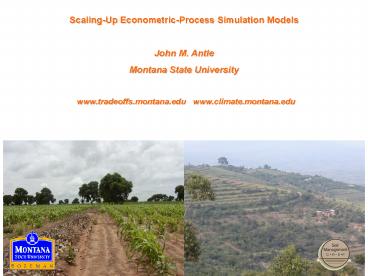ScalingUp EconometricProcess Simulation Models - PowerPoint PPT Presentation
1 / 8
Title:
ScalingUp EconometricProcess Simulation Models
Description:
But these systems interact with markets, policy and technology on a regional level. ... But what if we want to 'scale-up' the analysis to a larger regional level? ... – PowerPoint PPT presentation
Number of Views:41
Avg rating:3.0/5.0
Title: ScalingUp EconometricProcess Simulation Models
1
Scaling-Up Econometric-Process Simulation
Models John M. Antle Montana State University
www.tradeoffs.montana.edu www.climate.montana.ed
u
2
The Problem Agricultural production systems
interact with the environment on a site-specific
basis. But these systems interact with markets,
policy and technology on a regional level. How
can we bridge this gap with quantitative models
of production systems?
3
Econometric-process simulation models combine
site-specific data with biophysical process
models and economic simulation models to
characterize the population of economic decision
units in a region (Antle and Capalbo, 2001 AJAE)
4
The EPM approach has been successfully applied to
watershed-scale analysis, using farm-level survey
data. But what if we want to scale-up the
analysis to a larger regional level? Option 1
collect survey data adequate to represent the
larger region and apply the EPM approach. (best
in principle, but too slow, too costly) Option 2
extrapolate results from smaller to larger
areas that are similar (unknown errors, doesnt
work for dissimilar areas) Option 3 use
aggregate data for the larger region (feasible,
but causes aggregation errors, loses spatial
coherence) Option 4 use simpler EP-style models
applied to available secondary data (feasible but
introduces model approximation errors) An
Example Simulating Ag Soil Carbon Supply Curves
5
Spatial Distribution of OC and Contract
Participation Decisions
Carbon supply curve is derived from area between
0 and P under the density function
6
oc
C A ?c ?0P f(oc) doc
P0
f(oc)
C
C0
Cmax
0
Spatial Distribution of Opportunity Cost and
Carbon Supply Curve
7
Comparison of Four Scaling-Up Methods for
Simulation of Carbon Supply Curves for Montana
Dryland Agriculture
8
- Conclusions and Questions
- Why do the Min Data and Aggregate models behave
the way they do? - Can we generalize these results? If so, then
extrapolation from detailed case studies to
larger regions may be the best approach?































